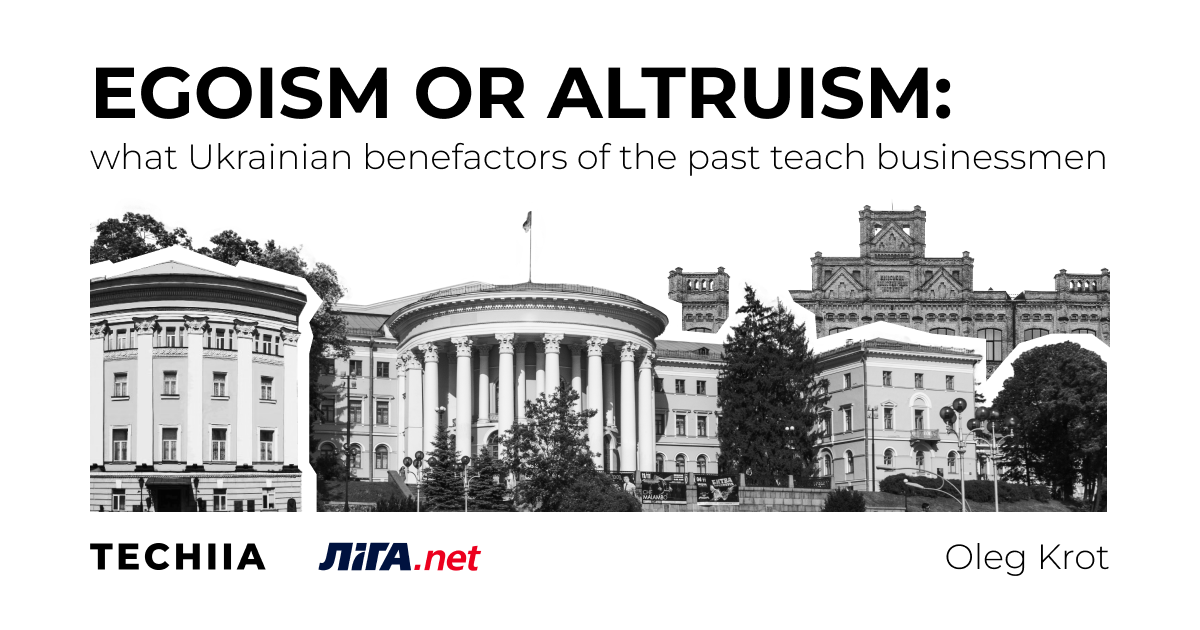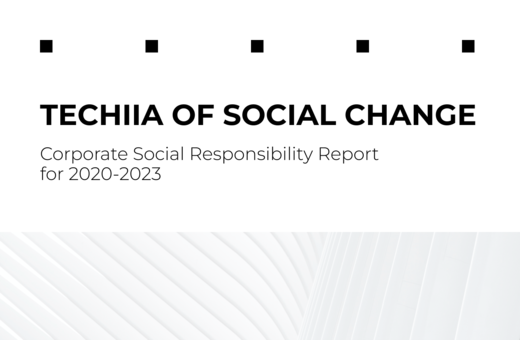
History of Ukrainian philanthropy of the past. Why businesses invest in social projects.
Botanical garden n.a. O. Fomin. The yellow building of Taras Shevchenko University. KPI. Okhmatdyt. Cobblestone of Andriyivskyy Descent. It is not a tour of the sights of Kyiv. All of the above was created thanks to the will and finances of Ukrainian patrons of the XIX century.
Doing something socially useful just because you can and think it is right is a long tradition of Ukrainian entrepreneurs.
Before the full-scale invasion of russia, I noticed an increase in social initiatives from business people of different levels. After the invasion, there was no time left for hesitation. Currently, I do not know a single entrepreneur who would not be involved in a larger or smaller unprotected sector.
Any charity is great. But I believe that our entrepreneurs have already grown to the point of creating, supporting or reforming entire sectors of the economy. You can start with education – for example, benefactors of the past did. Thanks to their projects, even more than 100 years later, we enjoy the benefits they gave to their cities.
Below are a few chapters from the history of Kyiv. Let's recall how much can change the realization of an entrepreneur that he is not only making money.
Fighting corruption with extra salaries
The period from 1839 to 1852 was perhaps the best in the history of the capital. That was the time of the cadence of Ivan Fundukley. The descendant of a successful businessman from Yelysavetgrad (Kropyvnytskyi) worked as an official of a lower rank.
When the Kyiv military governor Dmytro Bibikov noticed the consistent and sensible young man, the young functionary received an inheritance from his father, increased the number of assets, and became famous as a generous philanthropist. The last point was of particular interest to Bibikov. He took care of the appointment of a benefactor official in Kyiv.
The agreement between the newly-made colleagues was as follows: Fundukley manages the city at his discretion, and Bibikov "shows up at the right places" and does not interfere.
In the next 13 years, the following appeared in Kyiv:
- St. Volodymyr University (KNU named after T. Shevchenko);
- the Institute of Noble Girls (ICCA "October Palace");
- a school for poor girls (Presidium of the National Academy of Sciences of Ukraine);
- the gymnasium, which later became the Kyiv Cadet Corps (the yellow corps of T. Shevchenko National University).
The construction of a cobblestone road on the Andriyivskyy Descent, the establishment of a botanical garden, which now bears the name of Oleksandr Fomin, and the construction of a chain bridge across the Dnipro river were added to the educational institutions. And also overcoming corruption. Fundukley introduced an unofficial tenfold salary to police officers and officials. The governor financed compensation for honest work from his own resources.
Crime disappeared from the streets of Kyiv for these 13 years. Motivated by bonuses, police officers actively arrested "touring pickpockets," solved crimes, and sent them to jail instead of "fining" violators. Fundukley and the city's wealthiest residents replenished the salary budget in an envelope. The mayor did not get tired of explaining: "If entrepreneurs don't pay the police, criminals will."
Members of merchant guilds actively participated in the improvement of the city. Fundukley promised state awards to the most generous donors. Along with the award came tax breaks and other good bonuses. Most of all, the merchants were pleased with the prospect of receiving the nobility.
Before being transferred to Warsaw, Funduklei donated two of his own houses to the city to establish a women's gymnasium and money for its long-term maintenance. The gymnasium was named Fundukleivska and existed until the advent of Soviet power.
The Kyiv story of Ivan Funduklei is insightful for two reasons:
- for legislators — it is worth making the tax system flexible, perhaps even returning to the discussion of the law on patronage;
- for people in business – not to expect too much from the government, but to increase the scale of social projects so that in 170 years, the results of socially beneficial work will inspire future generations of Ukrainians.
Establishing a university in the kitchen
The development of sugar production gave Ukraine, especially Kyiv, medical, educational, and cultural institutions. The Tereshchenko family, together with their colleagues, acted for two reasons — investment and social. On the one hand, investing in the company's development and training specialists to service factories is necessary. On the other hand, paradise behind the fence is impossible. It's hard to be happy among the miserable.
Understanding the responsibility to society and the request to move up the social ladder pushed entrepreneurs to build orphanages, maternity hospitals for the poor, overnight shelters for those with nowhere to go, and hospitals. Okhmatdyt is one of them.
The institution's name at the time of its creation was Kyiv Tsesarevych Mykolay Free Hospital for laborers and the poor. In addition, the family contributed to the emergence of the building we know today as the National Operetta, the National Art Museum of Ukraine, and the Khanenko Museum.
For me, the most interesting CSR project of the Tereshchenko family is the foundation of KPI. The technological industry of today's Ukraine would not be possible without it. To understand the influence of the businessmen of that time, you should know that the decision to establish the institute was made during an informal meeting at home. Among the investors were the Tereshchenko family, Lazar Brodsky (a synagogue in the center of Kyiv bears his name), Mykola Hriakov, Kyiv City Duma, Kyiv Land Bank, and others. Contributions from business people accounted for half of the required budget. The rest was down to the government agencies.
From August 31, 1898, to this day, KPI has been training techies for Ukrainian and international technology companies. My partner and co-founder of TECHIIA is also from there. Like dozens of our colleagues in the holding.
The history of the "kitchen" foundation of KPI teaches a large-scale approach to problem-solving. And if the business is not ready to create universities, then implementing educational programs in partnership with academic institutions is a feasible prospect.
Money is not the (only) focus
I believe that every Ukrainian philanthropist — and fortunately, many of them now — can understand our predecessors in the emotional component. A strange mixture of egoism and altruism usually drives a social project. You see a painful problem that you can solve or at least reduce. You act - and it becomes better not only for yourself and your closest circle but also for total strangers.
I will explain. For example, many mature technology businesses invest in education and science. Joint training courses, mentoring and equipping universities and research institutes with modern equipment are not always about personnel training but the sector's general development.
One of the unusual manifestations of this movement is the cooperation between the Macpaw company and the "Akademik Vernadsky" Antarctic station. First, the colleagues handed over weather-resistant gadgets to scientists, and later they bought and delivered a powerful antenna to ensure communication. It took a year for coordination, purchase, and delivery because getting permits for a powerful device was difficult, as well as surviving the arduous journey to Antarctica.
The project from another sector is from the Zagoriy Foundation, an initiative of the founders of the "Darnytsia" pharmaceutical corporation. As an example, among many contributions to the development of the philanthropy culture, there is the "Eneid Project" exhibition. The curators have collected illustrations for the famous work, particularly from eminent artists.
The exhibition was held long before the war, but now such events are especially in demand. We must know more about ourselves, and learn to appreciate the cultural heritage before someone steals it.
Regarding TECHIIA, in addition to helping Ukrainian defenders, we are working on projects for medicine. We started this long before the creation of the holding itself and the "Techiia Foundation" NGO. It was prompted by our desire to do something so that children would not die from cancer.
This work regularly creates pleasant moments. For example, when busy hospitals in different regions receive modern equipment that facilitates the work of doctors and saves the lives of Ukrainians. Or when young patients of the "Eva" Inclusion and Correction Center, who have undergone severe cancer treatment, get better after rehabilitation.
Philanthropists, in particular, work to hear such stories more often than sad ones. I believe my colleagues from Kyivstar or SoftServe, where I have seen other projects for children's medicine, can confirm these words.
The development of the healthcare system is a matter for millions, so not everyone can afford it. However, there is always something that costs little. For example, one letter.
It was one letter from Ivan Aivazovsky that "attached" a young Odesa boy of Greek origin to the Academy of Arts at the end of the 19th century. And one conversation closed the issue of finances for a trip and an extended stay in another city. Ten years later, Kyriak Kostandi became a legend of Odesa. Together with his colleagues in the association of artists, he held more than a hundred exhibitions, including traveling ones. Such activity turned the relatively provincial town into a vital art point on the map.
Once, in a conversation about cinema, I heard the phrase, "Legendary lullabies are sung to Ukrainian cinema." It was during the dominance of the russian product, and only a few people were looking for a way to create the "made in Ukraine" product. It was about Dovzhenko, Parajanov, and many other artists of the past.
I can say the same about Ukrainian philanthropy. Its story is grand, and we can give it a new life. We all work to win, but businesses can already choose the sites they will take under their wing to improve public life. Wider and bigger than before.
Small initiatives should increase, and projects should take on a regional or even national scale. Big business can change the state of affairs in the humanitarian field - we have already seen this in recent crises. You just need to expand your boundaries.
Source:


